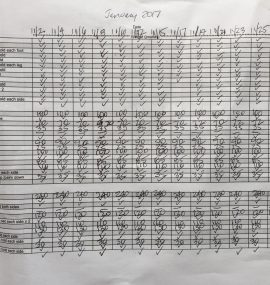If you sit most of the time and don’t move very much, you could be heading toward a health disaster. Overwhelming scientific evidence shows that physical activity helps protect you from a host of chronic conditions, including cardiovascular disease, stroke, and type 2 diabetes. And if that’s not enough, physical activity confers a host of benefits, including improved endurance, physical strength, and brain function. Anyone for better brain function?
The Centers for Disease Control and Prevention recommends that adults get 150 minutes of moderate- intensity aerobic exercise a week plus twice-weekly strength-building exercise. That roughly equates to walking 10,000 steps per day.
There’s a rule of thumb in the business world that says, “What doesn’t get measured, doesn’t get managed.” This rule applies to your health and well-being, as well. If you record how much physical activity you’re getting and check the results frequently, you’re more likely to get the physical activity you need. Fortunately, inexpensive tools can help you keep track.
Pedometers and high-tech fitness trackers record various measures of our daily activity, including the number of steps you take, the number of calories expended, and how many minutes you move around.
In 2015, I realized that I didn’t know how many minutes I moved around every day, plus I didn’t keep track of how often I went to the gym for strength training. First, I created a spreadsheet on my computer and carry a printed copy in my gym bag. I record all my exercises each time I go to the gym and note the date. Since then, at the end of each month, I check my spreadsheet for the previous month. I pat myself on the back for meeting my personal goal of going to the gym three times a week. I still use the spreadsheet. Seeing it filled out at the end of a month gives me a sense of accomplishment. The filled-out exercise log for January helps motivate me to keep going to the gym.
Last year, I bought a $23 pedometer and set a goal to walk 10,000 steps each day. It took only a week to realize that I needed to walk more to meet my daily step goal. Thus, I increased my daily walking. The pedometer data motivated me to walk more. I happened to read that Dr. Martin Seligman, the father of the positive psychology movement, adopted a goal of 12,500 steps per day. He’s four years older than I am. I upped my goal to 12,500 steps per day. Thanks, Marty!
Do yourself and your loved ones a favor and commit to moving around more. Set a step goal that seems reasonable to you. Buy a gadget that will count your steps and check it frequently. You’ll be more motivated to get the exercise you need for lifelong health and well-being.








